Malawi, Tanzania, and Uganda, August 2015
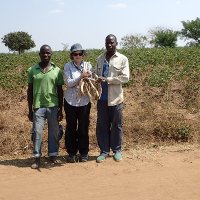 Malawian farmers with healthy cassava ready to be harvested. These farmers kindly allowed researchers to sample their fields for whitefly. Sarina Macfadyen (middle), was amazed by the generosity of the farmers.
Malawian farmers with healthy cassava ready to be harvested. These farmers kindly allowed researchers to sample their fields for whitefly. Sarina Macfadyen (middle), was amazed by the generosity of the farmers.
Source: CSIRO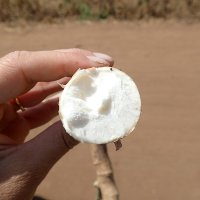 Healthy cassava ready to go to market.
Healthy cassava ready to go to market.
Source: CSIRO In East Africa, Cassava has many uses, and it is stored and prepared for eating in numerous ways.
In East Africa, Cassava has many uses, and it is stored and prepared for eating in numerous ways.
Source: CSIRO The research team visit a cassava field in Malawi.
The research team visit a cassava field in Malawi.
Source: CSIRO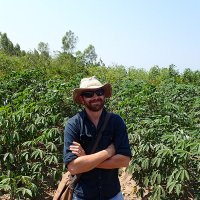 Andrew Hulthen, Research Technician, in front of a cassava field in Malawi, ready to look for whitefly!
Andrew Hulthen, Research Technician, in front of a cassava field in Malawi, ready to look for whitefly!
Source: CSIRO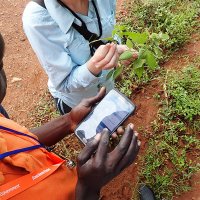 Looking for whitefly on non-crop host plants. Today's smart phones make digital data capture in the field much easier.
Looking for whitefly on non-crop host plants. Today's smart phones make digital data capture in the field much easier.
Source: CSIRO A cassava field in Lake region, Tanzania. Cassava mixed with other crops is common. Cate Paull and Paschal Chacha recording data on the number of whitefly adults and nymphs on the cassava.
A cassava field in Lake region, Tanzania. Cassava mixed with other crops is common. Cate Paull and Paschal Chacha recording data on the number of whitefly adults and nymphs on the cassava.
Source: CSIRO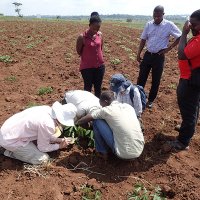 The Ugandan team inspecting a trial site with different cassava varieties. The whiteflies have nowhere to hide when there are this many entomologists around! Standing from left to right are Kasifa Katono, Andrew Kalyebi, and Wamani Sam.
The Ugandan team inspecting a trial site with different cassava varieties. The whiteflies have nowhere to hide when there are this many entomologists around! Standing from left to right are Kasifa Katono, Andrew Kalyebi, and Wamani Sam.
Source: CSIRO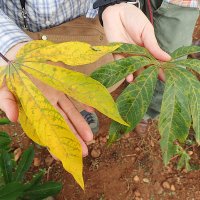 Cassava brown streak disease symptoms in leaves. The young leaf on the right has yellowing along veins, but in older leaves, that naturally turn yellow, this is seen as green lines along veins.
Cassava brown streak disease symptoms in leaves. The young leaf on the right has yellowing along veins, but in older leaves, that naturally turn yellow, this is seen as green lines along veins.
Source: CSIRO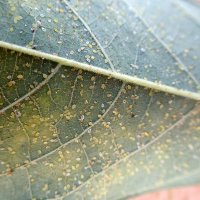 A close-up view of a heavily infested cassava leaf showing large numbers of whitefly nymphs.
A close-up view of a heavily infested cassava leaf showing large numbers of whitefly nymphs.
Source: CSIRO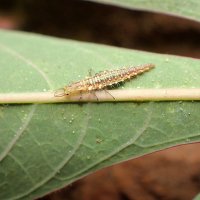 Predatory insects, like this lacewing larvae may be important for suppressing whitefly populations.
Predatory insects, like this lacewing larvae may be important for suppressing whitefly populations.
Source: CSIRO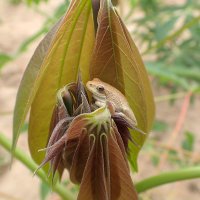 Cassava is home to many animals; not just whitefly!
Cassava is home to many animals; not just whitefly!
Source: CSIRO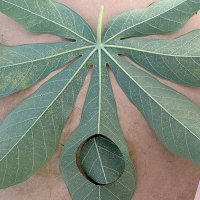 The underside of a heavily infested cassava leaf. The "dots" are whitefly nymphs. A leaf disc was taken out of the middle lobe to rear out the whitefly and see how many were parasitized by wasps.
The underside of a heavily infested cassava leaf. The "dots" are whitefly nymphs. A leaf disc was taken out of the middle lobe to rear out the whitefly and see how many were parasitized by wasps.
Source: CSIRO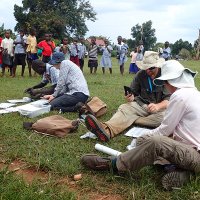 Processing leaf discs takes time; each needs an individual barcode. From left to right is Patrick Ocitti, Sarina Macfadyen, Andrew Hulthen and Cate Paull.
Processing leaf discs takes time; each needs an individual barcode. From left to right is Patrick Ocitti, Sarina Macfadyen, Andrew Hulthen and Cate Paull.
Source: CSIRO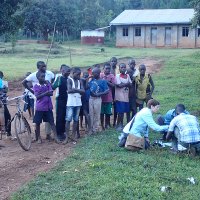 Processing cassava leaf samples often draws a crowd!
Processing cassava leaf samples often draws a crowd!
Source: CSIRO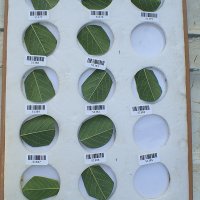 Leaf discs from multiple cassava plants. These will be kept for rearing out the whitefly and parasitoid wasps. Unique barcodes allow for keeping track of the data and tracing it back to each plant in each field sampled.
Leaf discs from multiple cassava plants. These will be kept for rearing out the whitefly and parasitoid wasps. Unique barcodes allow for keeping track of the data and tracing it back to each plant in each field sampled.
Source: CSIRO





